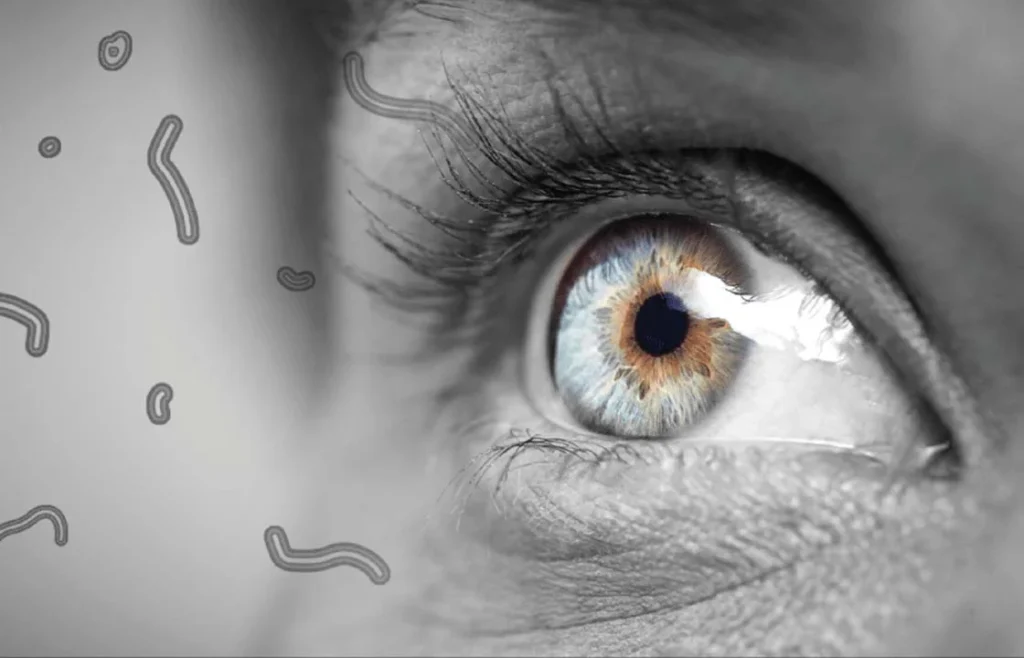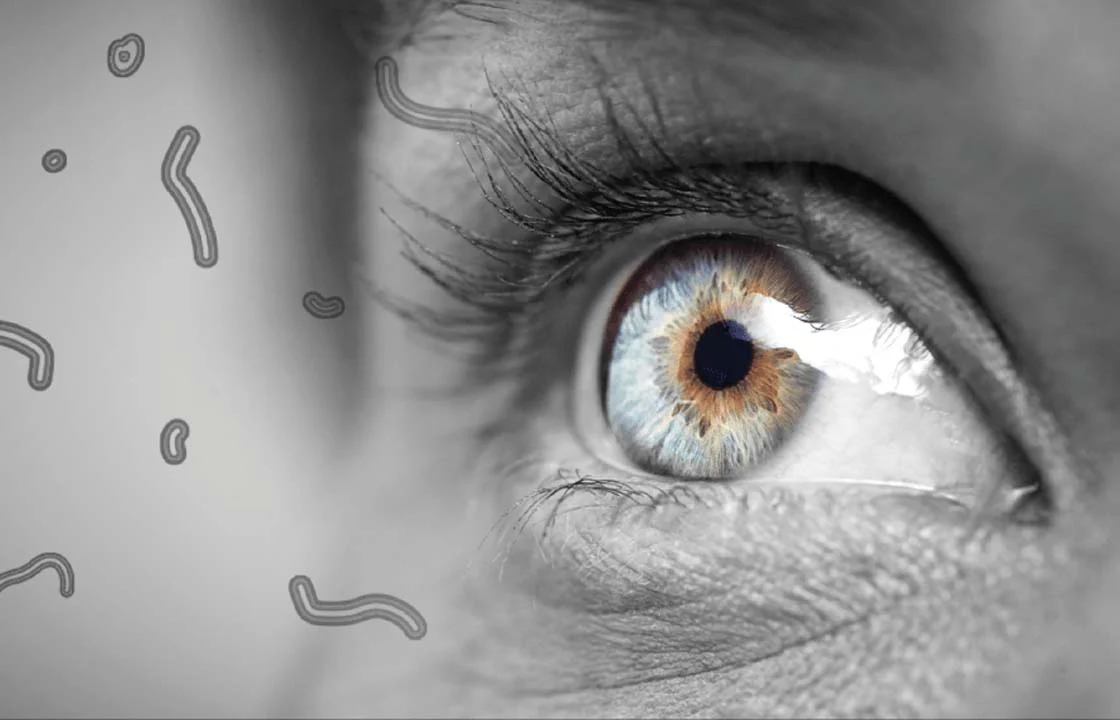Seeing tiny specks or threads drifting across your vision? You’re not alone. Many people want to get rid of an eye floater because it can be distracting or even frustrating. While most floaters are harmless, knowing what causes them and how to treat them can make a big difference in daily life.
What Are Eye Floaters?

Eye floaters look like small specks, dots, threads, or cobwebs. They move when your eyes move and often drift when you try to look at them directly. These shapes are most noticeable when you’re looking at a bright surface like the sky or a white screen. They may seem annoying, but most of the time, they’re not dangerous.
They form inside the clear gel called the vitreous that fills the back of your eye. As you age, this gel can shrink and get clumpy. The clumps cast shadows on your retina. That’s what you see as floaters. Even though most floaters are harmless, many people want to get rid of an eye floater because it interrupts clear vision. Sometimes floaters show up after an eye injury or surgery. If they change suddenly, it might point to a more serious issue, but most cases are mild. Still, many search for ways to get rid of an eye floater as they can be frustrating.
Common Causes
Age-related changes (vitreous shrinkage):
As people get older, the clear gel inside the eye (called the vitreous) starts to break down. It becomes more liquid and can pull away from the retina. This change causes small clumps or fibers to form, which then appear as floaters. This is the most common cause.
Eye trauma:
An injury to the eye can damage the vitreous or retina. That damage can lead to bleeding or scar tissue inside the eye, which can result in floaters. In some cases, this might require eye floater removal if vision gets blocked.
Inflammation (uveitis):
Inflammation inside the eye can cause debris to build up in the vitreous. This debris may look like floaters. People with autoimmune diseases are more likely to have this problem.
Nearsightedness (myopia):
People with severe nearsightedness often have longer eyeballs. This shape puts more stress on the vitreous, making floaters more likely. In some cases, floaters show up earlier in life for people with myopia.
Post-surgery effects:
Eye surgeries, like cataract removal, may cause changes inside the eye. Sometimes the vitreous is disturbed during surgery, which can lead to floaters. Rarely, small bubbles or particles left inside the eye after surgery may be seen as floaters.
Can Eye Floaters Go Away on Their Own?

Yes, some eye floaters do go away on their own — but not always. In many cases, they fade with time. The clumps inside the eye don’t fully disappear, but they move out of your central vision. This makes them less noticeable. Many people stop paying attention to them after a while.
The brain also plays a big role. Over time, it learns to ignore the floaters. This process is called neuroadaptation. It doesn’t fix the problem, but it helps you stop seeing them all the time. For people who want to get rid of an eye floater quickly, this may feel slow, but it works for many. In rare cases, floaters vanish completely, especially if they were caused by small particles or temporary swelling. If they don’t fade, people may turn to things like an eye floater supplement to try easing symptoms naturally.
Natural Approaches to Get Rid of Eye Floaters
Many people search for safe, natural ways to get rid of an eye floater, especially if the floaters are mild or new. While these methods don’t erase floaters completely, they may reduce how often you notice them or how much they affect your vision. Here’s a closer look at helpful habits that support overall eye health:
- Hydration:
The vitreous inside your eye is made mostly of water. When you don’t drink enough fluids, it can shrink or clump more easily. This makes floaters more visible. Drinking 6 to 8 glasses of water daily helps your body maintain the right balance and can slow down changes inside the eye. Hydration may not remove floaters, but it keeps the eye environment stable.
- Eat for eye support:
A healthy diet rich in antioxidants and omega-3 fatty acids helps protect your eyes. Foods like spinach, kale, carrots, oranges, sweet potatoes, eggs, and fish contain nutrients like lutein, vitamin A, vitamin C, and zinc. These help keep the retina and vitreous gel in better shape. If your diet lacks these, you might think about trying an eye floater supplement to help fill the gaps. Some people report mild improvement in symptoms after staying on a good supplement for a few months.
- Reduce screen time and eye strain:
Long hours of screen use can make you more aware of floaters. Digital eye strain also affects tear production and blinking, which can dry out the surface of the eye. Try using the 20-20-20 rule: every 20 minutes, look at something 20 feet away for 20 seconds. Giving your eyes rest lowers the chance of floaters feeling more annoying.
- Get enough sleep:
Sleep helps your body repair itself, including the tissues around the eyes. A tired eye is more sensitive to floaters. Aim for 7–9 hours of sleep each night to support healing and reduce eye stress.
- Wear sunglasses outdoors:
Bright sunlight makes floaters more visible. UV rays can also cause long-term damage to your retina. Wearing sunglasses with full UV protection lowers contrast and glare, making floaters harder to notice.
- Avoid rubbing your eyes or heavy strain:
Rubbing can increase pressure inside the eye and lead to more irritation. It also raises the risk of tiny injuries or inflammation that may make floaters worse.
These habits won’t completely get rid of an eye floater, but they may help limit the impact floaters have on your daily life. Staying consistent with these changes gives your eyes the best chance to adjust and may reduce the need for more serious steps like eye floater laser treatment.
Medical Treatments to Get Rid of Eye Floaters
For people who want fast, lasting ways to get rid of an eye floater, medical treatment might be an option. These are usually for those with large or very bothersome floaters that don’t fade over time. There are two main treatments doctors may offer.
1. Laser vitreolysis
This treatment uses a laser to break up floaters inside the eye. The laser targets the clumps in the vitreous and turns them into smaller pieces, which may make them less noticeable. It’s done in a clinic, and most people don’t need anesthesia.
- Who it’s for:
Best for people with a few large floaters far from the retina and lens. Not all floaters can be treated this way. - What to expect:
The procedure takes about 20–60 minutes. Some need more than one session. It has fewer risks than surgery, but still isn’t risk-free. - Risks:
Temporary blurry vision, eye pressure changes, and rare cases of retinal damage. - Cost:
It’s often not covered by insurance. One session may cost around $1,000–$2,500 depending on location.
People considering eye floater laser treatment should meet with an eye doctor who has experience with this tool. Not all clinics offer it.
2. Vitrectomy
This is a surgical procedure where a doctor removes the vitreous gel and replaces it with a clear solution. It gets rid of floaters almost completely, but it’s more invasive.
- Who it’s for:
Only used when floaters severely affect vision or quality of life. This is not a first choice treatment. - What to expect:
Surgery is done in a hospital or surgical center. Recovery may take weeks. - Risks:
Includes infection, bleeding, cataracts, and retinal detachment. These risks are higher than with laser. - Cost:
It can range from $5,000–$10,000 or more. Insurance might cover it if the case is severe.
Surgery can get rid of an eye floater almost entirely, but because of the risks, most doctors suggest trying other options first. If floaters are mild, rest and diet changes are safer. But if floaters stop you from driving, reading, or seeing clearly, procedures like eye floater removal may be worth discussing with a specialist.
When Should You Be Worried
Most floaters are harmless and don’t need treatment. But there are times when floaters could signal a serious problem. It’s important to know when to act fast.
See an eye doctor right away if you notice:
- A sudden increase in floaters
One or two new floaters aren’t unusual. But a sudden shower of floaters can be a warning sign. - Flashes of light in your side vision
These may feel like lightning or flickers. They can happen when the retina gets pulled or torn. - A dark curtain or shadow in your vision
This could mean the retina is detaching. It blocks part of your sight and needs emergency care. - Blurry vision or partial loss of vision
If floaters come with sudden blur or missing areas in your sight, don’t wait. Get medical help now. - After an eye injury or surgery
New floaters after trauma or a procedure should always be checked to rule out damage.
These symptoms can point to a retinal tear or detachment, which can lead to blindness if not treated quickly. It’s better to check early than wait. Even if your goal is just to get rid of an eye floater, your eye safety comes first. Always let a professional decide what’s normal and what’s not.
